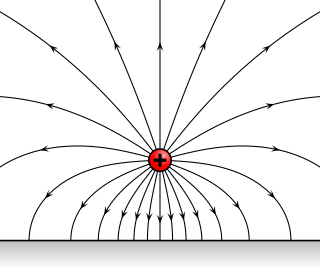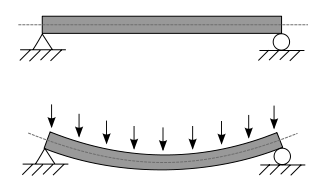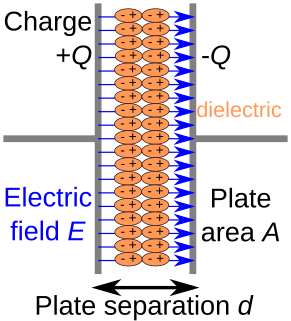In molecular physics/nanotechnology, electrostatic deflection is the deformation of a beam-like structure/element bent by an electric field (Fig. 1). It can be due to interaction between electrostatic fields and net charge or electric polarization effects. The beam-like structure/element is generally cantilevered (fix at one of its ends). In nanomaterials, carbon nanotubes (CNTs) are typical ones for electrostatic deflections.
Molecular physics is the study of the physical properties of molecules, the chemical bonds between atoms as well as the molecular dynamics. Its most important experimental techniques are the various types of spectroscopy; scattering is also used. The field is closely related to atomic physics and overlaps greatly with theoretical chemistry, physical chemistry and chemical physics.
Nanotechnology ("nanotech") is manipulation of matter on an atomic, molecular, and supramolecular scale. The earliest, widespread description of nanotechnology referred to the particular technological goal of precisely manipulating atoms and molecules for fabrication of macroscale products, also now referred to as molecular nanotechnology. A more generalized description of nanotechnology was subsequently established by the National Nanotechnology Initiative, which defines nanotechnology as the manipulation of matter with at least one dimension sized from 1 to 100 nanometers. This definition reflects the fact that quantum mechanical effects are important at this quantum-realm scale, and so the definition shifted from a particular technological goal to a research category inclusive of all types of research and technologies that deal with the special properties of matter which occur below the given size threshold. It is therefore common to see the plural form "nanotechnologies" as well as "nanoscale technologies" to refer to the broad range of research and applications whose common trait is size. Because of the variety of potential applications, governments have invested billions of dollars in nanotechnology research. Through 2012, the USA has invested $3.7 billion using its National Nanotechnology Initiative, the European Union has invested $1.2 billion, and Japan has invested $750 million.
In materials science, deformation refers to any changes in the shape or size of an object due to
Mechanisms of electric deflection due to electric polarization can be understood as follows:
As shown in Fig.2, when a material is brought into an electric field (E), the field tends to shift the positive charge (in red) and the negative charge (in blue) in opposite directions. Thus, induced dipoles are created. Fig. 3 shows a beam-like structure/element in an electric field. The interaction between the molecular dipole moment and the electric field results an induced torque (T). Then this torque tends to align the beam toward the direction of field.

An electric field surrounds an electric charge, and exerts force on other charges in the field, attracting or repelling them. Electric field is sometimes abbreviated as E-field. Mathematically the electric field is a vector field that associates to each point in space the force per unit of charge exerted on an infinitesimal positive test charge at rest at that point. The SI unit for electric field strength is volt per meter (V/m). Newtons per coulomb (N/C) is also used as a unit of electric field strengh. Electric fields are created by electric charges, or by time-varying magnetic fields. Electric fields are important in many areas of physics, and are exploited practically in electrical technology. On an atomic scale, the electric field is responsible for the attractive force between the atomic nucleus and electrons that holds atoms together, and the forces between atoms that cause chemical bonding. Electric fields and magnetic fields are both manifestations of the electromagnetic force, one of the four fundamental forces of nature.

A beam is a structural element that primarily resists loads applied laterally to the beam's axis. Its mode of deflection is primarily by bending. The loads applied to the beam result in reaction forces at the beam's support points. The total effect of all the forces acting on the beam is to produce shear forces and bending moments within the beam, that in turn induce internal stresses, strains and deflections of the beam. Beams are characterized by their manner of support, profile, length, and their material.

Torque, moment, or moment of force is the rotational equivalent of linear force. The concept originated with the studies of Archimedes on the usage of levers. Just as a linear force is a push or a pull, a torque can be thought of as a twist to an object. The symbol for torque is typically , the lowercase Greek letter tau. When being referred to as moment of force, it is commonly denoted by M.
In case of a cantilevered CNT (Fig. 1), it would be bent to the field direction. Meanwhile the electrically induced torque and stiffness of the CNT compete against each other. This deformation has been observed in experiments. [1] [2] This property is an important characteristic for CNTs promising nanoelectromechanical systems applications, as well as for their fabrication, separation and electromanipulation. Recently, several nanoelectromechanical systems based on cantilevered CNTs have been reported such as: nanorelays, [3] [4] nanoswitches, [5] nanotweezers [6] and feedback device [7] which are designed for memory, sensing or actuation uses. Furthermore, theoretical studies have been carried out to try to get a full understanding of the electric deflection of carbon nanotubes. [8]

Stiffness is the extent to which an object resists deformation in response to an applied force.

Nanoelectromechanical systems (NEMS) are a class of devices integrating electrical and mechanical functionality on the nanoscale. NEMS form the logical next miniaturization step from so-called microelectromechanical systems, or MEMS devices. NEMS typically integrate transistor-like nanoelectronics with mechanical actuators, pumps, or motors, and may thereby form physical, biological, and chemical sensors. The name derives from typical device dimensions in the nanometer range, leading to low mass, high mechanical resonance frequencies, potentially large quantum mechanical effects such as zero point motion, and a high surface-to-volume ratio useful for surface-based sensing mechanisms. Uses include accelerometers, or detectors of chemical substances in the air.
Electromanipulation refers to the act or practice of manipulating materials using electric fields. In nanotechnology, nanomaterials are so small that they can hardly be directly mechanically manipulated. Hence, electric fields are applied to them to make field-induced movements or deformations.










